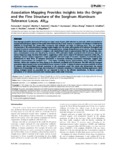Por favor, use este identificador para citar o enlazar este ítem:
http://www.alice.cnptia.embrapa.br/alice/handle/doc/979541Registro completo de metadatos
| Campo DC | Valor | Lengua/Idioma |
|---|---|---|
| dc.contributor.author | CANIATO, F. F. | pt_BR |
| dc.contributor.author | HAMBLIN, M. T. | pt_BR |
| dc.contributor.author | GUIMARAES, C. T. | pt_BR |
| dc.contributor.author | ZHANG, Z. | pt_BR |
| dc.contributor.author | SCHAFFERT, R. E. | pt_BR |
| dc.contributor.author | KOCHIAN, L. V. | pt_BR |
| dc.contributor.author | MAGALHAES, J. V. | pt_BR |
| dc.date.accessioned | 2014-02-12T11:11:11Z | pt_BR |
| dc.date.available | 2014-02-12T11:11:11Z | pt_BR |
| dc.date.created | 2014-02-12 | pt_BR |
| dc.date.issued | 2014 | pt_BR |
| dc.identifier.citation | Plos One, San Francisco, v. 9, n. 1, p. 1-12, 2014. | pt_BR |
| dc.identifier.uri | http://www.alice.cnptia.embrapa.br/alice/handle/doc/979541 | pt_BR |
| dc.description | Root damage caused by aluminum (Al) toxicity is a major cause of grain yield reduction on acid soils, which are prevalent in tropical and subtropical regions of the world where food security is most tenuous. In sorghum, Al tolerance is conferred by SbMATE, an Al-activated root citrate efflux transporter that underlies the major Al tolerance locus, AltSB, on sorghum chromosome 3. We used association mapping to gain insights into the origin and evolution of Al tolerance in sorghum and to detect functional variants amenable to allele mining applications. Linkage disequilibrium across the AltSB locus decreased much faster than in previous reports in sorghum, and reached basal levels at approximately 1000 bp. Accordingly, intralocus recombination events were found to be extensive. SNPs and indels highly associated with Al tolerance showed a narrow frequency range, between 0.06 and 0.1, suggesting a rather recent origin of Al tolerance mutations within AltSB.A haplotype network analysis suggested a single geographic and racial origin of causative mutations in primordial guinea domesticates in West Africa. Al tolerance assessment in accessions harboring recombinant haplotypes suggests that causative polymorphisms are localized to a, 6 kb region including intronic polymorphisms and a transposon (MITE) insertion, whose size variation has been shown to be positively correlated with Al tolerance. The SNP with the strongest association signal, located in the second SbMATE intron, recovers 9 of the 14 highly Al tolerant accessions and 80% of all the Al tolerant and intermediately tolerant accessions in the association panel. Our results also demonstrate the pivotal importance of knowledge on the origin and evolution of Al tolerance mutations in molecular breeding applications. Allele mining strategies based on associated loci are expected to lead to the efficient identification, in diverse sorghum germplasm, of Al tolerant accessions able maintain grain yields under Al toxicity. | pt_BR |
| dc.language.iso | eng | eng |
| dc.rights | openAccess | eng |
| dc.title | Association mapping provides insights into the origin and the fine structure of the sorghum aluminum tolerance locus, AltSB. | pt_BR |
| dc.type | Artigo de periódico | pt_BR |
| dc.date.updated | 2017-05-24T11:11:11Z | pt_BR |
| dc.subject.thesagro | Sorgo | pt_BR |
| dc.subject.thesagro | Alumínio | pt_BR |
| dc.subject.thesagro | Toxidez | pt_BR |
| dc.subject.thesagro | Melhoramento genético vegetal | pt_BR |
| dc.subject.thesagro | Sorghum bicolor | pt_BR |
| dc.subject.nalthesaurus | Plant breeding | pt_BR |
| dc.subject.nalthesaurus | Toxicity | pt_BR |
| riaa.ainfo.id | 979541 | pt_BR |
| riaa.ainfo.lastupdate | 2017-05-24 | pt_BR |
| dc.identifier.doi | 10.1371/journal.pone.0087438 | pt_BR |
| dc.contributor.institution | CLAUDIA TEIXEIRA GUIMARAES, CNPMS; ROBERT EUGENE SCHAFFERT, CNPMS; JURANDIR VIEIRA DE MAGALHAES, CNPMS. | pt_BR |
| Aparece en las colecciones: | Artigo em periódico indexado (CNPMS)  | |
Ficheros en este ítem:
| Fichero | Descripción | Tamaño | Formato | |
|---|---|---|---|---|
| Associationmapping.pdf | 1,06 MB | Adobe PDF |  Visualizar/Abrir |









